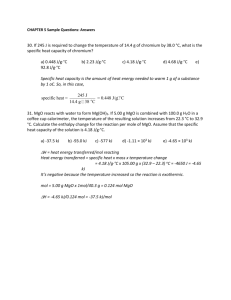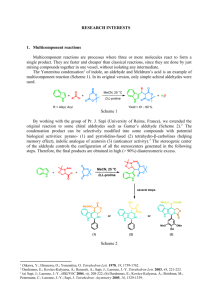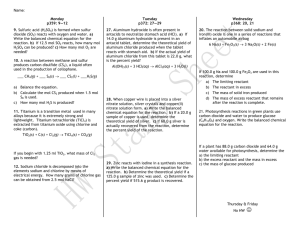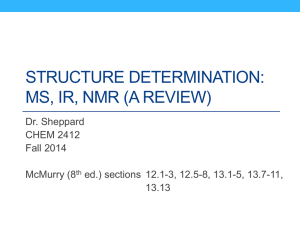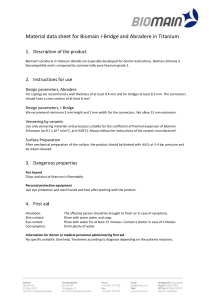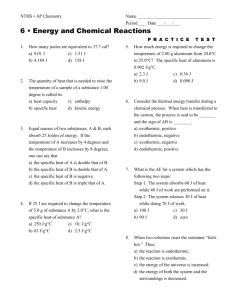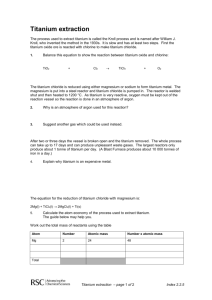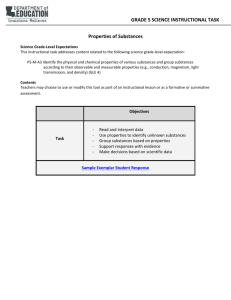Ethyl thioacrylate was difuctionalized by a tandem XC/C=C bond
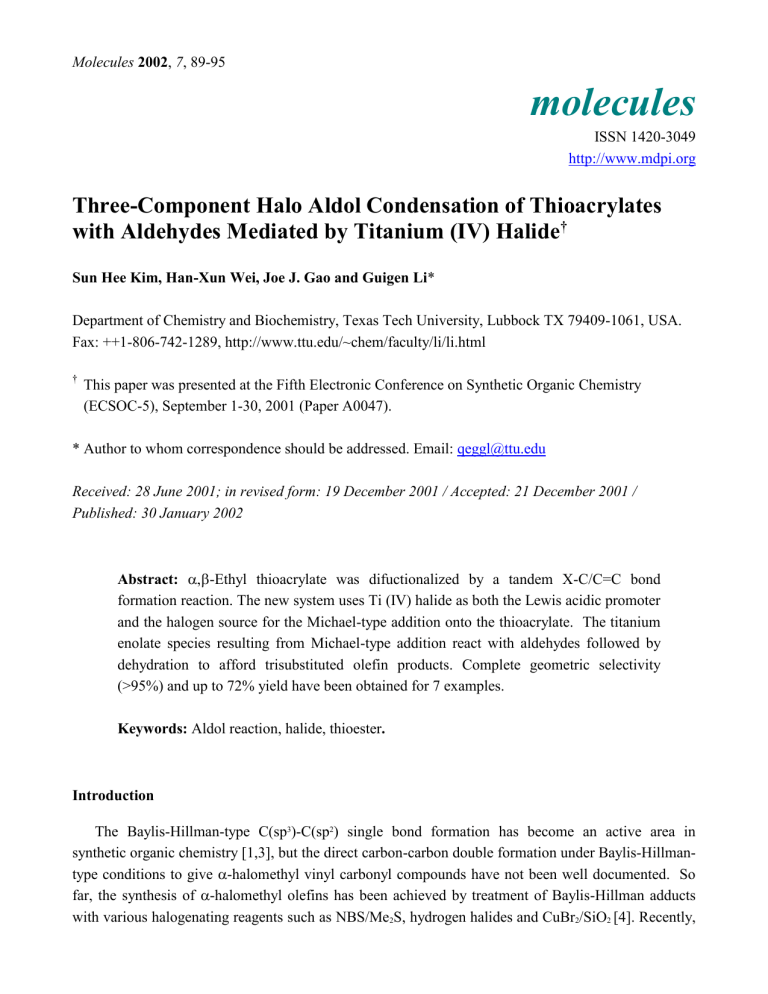
Molecules 2002 , 7 , 89-95
molecules
ISSN 1420-3049 http://www.mdpi.org
Three-Component Halo Aldol Condensation of Thioacrylates with Aldehydes Mediated by Titanium (IV) Halide
†
Sun Hee Kim, Han-Xun Wei, Joe J. Gao and Guigen Li *
Department of Chemistry and Biochemistry, Texas Tech University, Lubbock TX 79409-1061, USA.
Fax: ++1-806-742-1289, http://www.ttu.edu/~chem/faculty/li/li.html
†
This paper was presented at the Fifth Electronic Conference on Synthetic Organic Chemistry
(ECSOC-5), September 1-30, 2001 (Paper A0047).
* Author to whom correspondence should be addressed. Email: qeggl@ttu.edu
Received: 28 June 2001; in revised form: 19 December 2001 / Accepted: 21 December 2001 /
Published: 30 January 2002
Abstract: -Ethyl thioacrylate was difuctionalized by a tandem X-C/C=C bond formation reaction. The new system uses Ti (IV) halide as both the Lewis acidic promoter and the halogen source for the Michael-type addition onto the thioacrylate. The titanium enolate species resulting from Michael-type addition react with aldehydes followed by dehydration to afford trisubstituted olefin products. Complete geometric selectivity
(>95%) and up to 72% yield have been obtained for 7 examples.
Keywords: Aldol reaction, halide, thioester .
Introduction
The Baylis-Hillman-type C(sp 3 )-C(sp 2 ) single bond formation has become an active area in synthetic organic chemistry [1,3], but the direct carbon-carbon double formation under Baylis-Hillmantype conditions to give -halomethyl vinyl carbonyl compounds have not been well documented. So far, the synthesis of -halomethyl olefins has been achieved by treatment of Baylis-Hillman adducts with various halogenating reagents such as NBS/Me
2
S, hydrogen halides and CuBr
2
/SiO
2
[4]. Recently,
Molecules 2002 , 7 90 we developed a new method for the synthesis of -halomethyl vinyl ketones via a one-pot tandem difunctionalization of , -unsaturated ketones [5,6]. The reaction was mediated in a highly stereoselective manner by a non-stoichiometric amount of titanium (IV) halides or a mixture of
TiCl
4
/( n -Bu)
4
NI (and/or TiBr
4
/( n Bu)
4
NI) (Scheme 1). To extend the scope of this reaction, we have utilized -unsaturated alkyl acrylates and related substrates to replace the ketones for this new reaction but without success. We now found that -unsaturated ethyl thioacrylate can be functionalized to afford -halomethyl -substituted vinyl thioesters under modified conditions. In this paper, we report this new method which is represented by Scheme 2.
Scheme 1
O O O
H +
H
TiX
4
(0.5 eq) or
TiX
4
(0.26 eq)/(n-Bu)
4
NI (0.26 eq), r.t., 24 h (X = Cl, Br)
X
H
Scheme 2
O O
O
MeO
H
+
SEt
TiCl
4
(1.0 eq)/(n-Bu)
4
NI (0.25 eq) r.t. to reflux, 24 h.
MeO Cl
SEt
72%, Z/E selectivity >95%
Results and Discussion
The new one-pot and three-component reaction was performed simply by mixing the aldehyde,
, -unsaturated thioester and TiCl
4
/(n-Bu)
4
NI in dichloromethane solution at room temperature followed by heating to reflux for 24 hours. The increased ratio of TiCl
4
to (n-Bu)
4
NI (TiCl
4
/(n-Bu)
4
NI
= 4/1) was proven to be necessary for the reaction, although relatively low yields were obtained for most cases at this stage as shown in Table 1, for which the relatively more complex and stable intermediates generated from the new thioester substrate are responsible. The initial reaction was carried out by reacting ethyl thioacrylate with benzaldehyde in the presence of TiCl
4
(0.5 eq), or TiCl
4
(0.26 eq)/( n -Bu)
4
NI (0.26 eq) in dichloromethane at room temperature as previously described [5].
Unfortunately, only a tiny amount of the expected product was observed even after prolonged reaction times (>24 hours) with less than 50% consumption of starting material. The major side product was determined to be the undehydrated haloaldol adduct. Raising the reaction temperature resulted in little improvement, giving less than 30% yield. When the loading of TiCl
4
was increased to 1.0 equiv, the chemical yield was enhanced to 45%. Similar observations were realized for two other substrates, p -
Molecules 2002 , 7 91 chloro and p -chlorobenzaldehyde (entries 3 and 4 of Table 1). Interestingly, the highest yield (72 %) was obtained when a strong electron-donating substituted aldehyde, p -methoxybenzaldehyde, was employed as the substrate (entry 2). For this substrate, a smaller amount of TiCl
4
(10 mol%) can also accomplish the reaction at room temperature without heating to give a similar yield. This observation can be explained by the fact that the electronically rich aldehyde helps to dissociate chlorine anion from
TiCl
4
for the Michael-type addition.
Table 1.
Results of TiCl
4
/( n -Bu)
4
NI-Mediated C=C Bond Formation
O O
O
R H
+
SEt
TiCl
4
(1,0 eq)/(n-Bu)
4
NI (0.25 eq)
R SEt r.t. to reflux
Cl
Entry R- product m.p.( °C ) yield (%) a
O
1
P h
SEt
oil 45
Cl
O
2 b
MeO 4-MeO P h
SEt
oil 72
Cl
O
Cl 4-Cl P h
SEt oil 55
3
Cl
O
Br 4-Br P h
SEt 35-36 52
4
Cl
O
5
Me(CH
2
)
8
Me(CH
2
)
8
Cl
SEt
oil 56
O
6
P h
SEt oil 43
Cl
O
7 2-NO
2
P h
SEt
121-122 65
NO
2
Cl a
Purified yields. Only Z / E isomer was observed by crude 1 H-NMR determination. b
The reaction can be finished at room temperature in the presence of 10 mol% of ( n -Bu)
4
NI.
Molecules 2002 , 7 92
Even though aldol condensation products were produced predominantly for most cases, the nondehydrated aldol adducts were obtained in 82% yield when para-nitrobenzaldehyde was employed as the carbonyl acceptor under the same conditions. The same situation was encountered when an acrylonitrile substrate was used as the Michael acceptor [7a]. As revealed in previous reports [5], the nondehydrated aldol adducts are also very useful for organic synthesis, particularly, when they are transformed to the Baylis-Hillman aldohols by treatment with tertiary amines [7].
As in the previous systems studied [5,6], dichloromethane was proven to be the most effective solvent for this reaction. Besides titanium tetrachloride, its bromide counterpart (TiBr
4
) can also be utilized as the Lewis acid promoter and the halogen source (Scheme 3). The latter process gives a slightly lower yield (51%) with complete geometric selectivity. For both TiCl
4
and TiBr
4
-based systems, no iodinated products were observed even in the presence of tetrabutylammonium iodide. The major role of the iodine anion of tetrabutylammonium iodide would then be to push Br- or Cl- off their corresponding titanium halides. This observation tells that -unsaturated ethyl thioacrylate is not a good enough Michael-type acceptor to accept iodine anion under the present conditions. This is in contrast to the previous processes [5,6c], where the iodinated products were either formed predominantly or in small amounts.
Scheme 3
O O O
H +
SEt
TiBr
4
(1,0 eq)/(n-Bu)
4
NI (0.25 eq)
2NO
2
-Ph SEt
CH
2
Cl
2
, r.t. to reflux
2NO
2
-Ph
Br
8 , 51%, one isomer, m.p. 127-128 o C
The mechanism of this process could be similar to those of previous X-C/C-C and X-C/C=C bond formation reactions 3-5, 7a]. In the initial step, one of the chlorine anions released from TiCl
4
is added onto the -unsaturated thioester to give titanium enolates. The enolate formation is accelerated by the coordination of the carbonyl oxygen onto the titanium halide ( C=O--Ti interaction)[8] to further free the chlorine anion from TiCl
4
. This coordination can also polarize the -conjugate C=C double bond to favor the conjugate addition. The resulting titanium species can serve as Lewis acids to activate aldehydes for the subsequent carbonyl additions.
Conclusions
A new three-component reaction system has been developed for the synthesis of -halomethyl , unsaturated thioesters via tandem formations of X-C and C=C bonds. Both TiCl
4
and TiBr
4
can be used as the halogen sources and promoters for , -unsaturated thioester substrates. An increased ratio
Molecules 2002 , 7 93 of TiCl
4
/( n -Bu)
4
NI (4:1) has been proven to be necessary for the reaction. Complete geometric selectivity has been obtained for all cases which were examined.
Acknowledgments
We gratefully acknowledge the National Institutes of Health, General Medical Sciences (GM-
60261) and the Robert A. Welch Foundation (D-1361) for their generous support of this work.
Experimental
General
Dichloromethane and propionitrile was dried and freshly distilled from calcium hydride under a nitrogen atmosphere. Other commercial chemicals were used without further purification and their stoichiometries were calculated based on the purities reported by the manufacturers. Flash chromatography was performed on E. Merck silica gel 60 (230-400 mesh). Thin layer chromatography was performed on Merck Kieselgel 60 GF
254
plates (0.2 mm thickness). 1 H-NMR (300 MHz) and
13 C-NMR spectra (75 MHz) spectra were recorded on a Varian 300 MHz NMR spectrometer using
CDCl
3
as solvent. The spectral data are reported in the following format: chemical shift (all relative to
Me
4
Si as an internal reference standard unless otherwise indicated), multiplicity (s = singlet, d = doublet, dd = doublet of doublets, t = triplet, q = quartet, m = multiplet, b = broad).
Typical Experimental Procedure
Benzaldehyde (0.107 g, 1.00 mmol), tetrabutylammonium iodide (0.094 g, 0.25 mmol) and CH
2
Cl
2
(3.0 mL) were loaded into a clean, dry round bottomed flask. The flask was attached to a reflux condenser and the contents protected by nitrogen gas. A solution of ethyl thioacrylate (0.15 g, 1.30 mmol) in 2 mL of CH
2
Cl
2
and 1 M titanium chloride (1.0 mL) in the same solvent were then added dropwise via a syringe. The reaction mixture was stirred for 1 h at room temperature and then heated to reflux. The reaction was monitored by GC or TLC until the aldehyde was completely consumed. The reaction was then quenched by saturated aqueous NaHSO
3
. The organic layer was separated and the aqueous layer was extracted with dichloromethane (3 x 5.0 mL). The combined organic layers were dried over anhydrous MgSO
4
and concentrated. Purification was carried out by column chromatography (ethyl acetate/hexane = 1:20, v/v) to give the product 1 (0.108 g, 45 % yield) as a colorless oil.
Spectral data
Molecules 2002 , 7 94
1 : 1 H-NMR: 7.80 (s, 1H), 7.57-7.55 (m, 2H), 7.46-7.43 (m, 3H), 4.49 (s, 2H), 3.04 (q, J =7.42Hz,
2H), 1.34 (t, J =7.42Hz, 3H); 13 C-NMR: 192.0, 141.3, 136.1, 133.8, 129.8, 129.7, 128.9, 38.4,
23.8, 14.5.
2 : 1 H-NMR: 7.77 (s, 1H), 7.59-7.56 (m, 2H), 7.00-6.97 (m, 2H), 4.53 (s, 2H), 3.86 (s, 3H), 3.03 (q,
J=7.42Hz, 2H), 1.33 (t, J =7.42Hz, 3H); 13 C-NMR: 192.0, 141.6, 138.7, 133.9, 132.0, 128.3,
114.4, 55.4, 38.9, 23.7, 14.6.
3 : 1 H-NMR: 7.73 (s, 1H), 7.52-7.41 (m, 4H), 4.45 (s, 2H), 3.04 (q, J =7.41Hz, 2H), 1.33 (t, J
=7.41Hz, 3H); 13 C-NMR: 191.7, 139.7, 136.5,135.9, 132.1, 130.9, 129.1, 38.1, 23.8, 14.5.
4 : 1 H-NMR: 7.71 (s, 1H), 7.61-7.58 (m, 2H), 7.45-7.42 (m, 2H), 4.45 (s, 2H), 3.05 (q, J =7.42 Hz,
2H), 1.34 (t, J = 7.42 Hz, 3H); 13 C-NMR: 191.9, 139.9, 136.7, 132.7, 132.2, 131.2,131.1, 124.4,
38.2, 23.9, 14.5.
5 : 1 H-NMR: 6.94 (t, J = 7.56Hz, 1H), 4.33 (s, 2H), 2.97 (q, J=7.42Hz, 2H), 2.35 (q, J=7.46Hz, 2H),
1.55-150 (m, 2H), 1.37-1.21 (m, 5H), 0.88 (m, 3H); 13 C-NMR: 191.5, 146.7, 137.0, 36.5, 31.8,
29.4, 29.3 (2), 29.2, 28.9, 28.4, 23.4, 22.6, 14.6, 14.1.
6 : 1 H-NMR: 7.56-7.46 (m, 3H, 7.40-7.35 (m, 3H), 7.20-7.04 (m, 2H), 4.54 (s, 2H), 3.02 (q,
J=7.43Hz, 2H), 1.31 (t, J=7.43Hz, 3H); 13 C-NMR: 190.9, 143.6, 141.2, 135.7, 134.4, 129.8, 128.9,
127.7, 122.3, 36.8, 23.6, 14.7.
7 : 1 H-NMR: 8.03 (dd, J=1.28, 8.16Hz, 1H), 7.76 (dd, J= 1.37, 7.86 Hz, 1H), 7.67 (m, 1H), 7.59-7.47
(m, 3H), 7.11 (dd, J = 11.3, 15.2Hz, 1H), 4.53 (s, 2H), 3.03 (q, J=7.41Hz, 2H), 1.33 (t, J=7.41Hz,
3H); 13 C-NMR: 191.1, 148.1, 139.8, 137.4, 136.6, 133.4, 131.5, 129.7, 128.7, 126.9, 125.0, 36.5,
23.7, 14.6.
8 : 1 H-NMR: 8.03 (dd, J=1.28, 8.6Hz, 1H), 7.77 (dd, J=1.28, 7.9Hz, 1H), 7.67 (m, 1H), 7.61-7.45 (m,
3H), 7.10 (dd, J=11.3, 15.2Hz, 1H), 4.43 (s, 2H), 3.04 (q, J= 7.41Hz, 2H), 1.33 (t, J =7.41Hz, 3H);
13 C-NMR: 190.9, 148.1, 139.2, 137.1, 137.0, 133.5, 131.6, 129.7, 128.7, 127.1, 125.1, 23.8, 23.1,
14.6.
References
1.
For reviews regarding the Baylis-Hillman reaction see: (a) Ciganek, E. Org. React., 1997 , 51 , 201;
(b) Basavaiah, D.; Rao, P. D.; Hyma, R. S. Tetrahedron 1996 , 52 , 8001. (c) Zhang, A. M.; Wang,
W.; Lin, G. Q. Chinese J. Org. Chem . 2001 21 , 134. (d) Li, G.; Hook, J.; Wei, H.-X. in "Recent
Research Developments in Organic & Bioorganic Chemistry", Transworld Research Network,
2001 , 4 , 49.
2.
(a) Brzezinski, L. J.; Rafel, S.; Leahy, J. M. J. Am. Chem. Soc. 1997 , 119 , 4317. (b) Iwabuchi, Y.;
Nakatani, M.; Yokoyama, N.; Hatakeyama, S. J. Am. Chem. Soc. 1999 , 121 , 10219. (c) Barrett, A.
G. C.; Cook, A. S.; Kamimura, A. Chem. Commun.
, 1998 , 2533. (d) Kawamura, M.; Kobayashi, S.
Tetrahedron Lett.
1999 , 40 , 1539.
3.
(a) Li, G.; Wei, H.-X.; Caputo, T. D. Tetrahedron Lett.
2000 , 41 , 1. (b) Li, G.; Wei, H.-X.; Phelps,
B. S.; Purkiss, D. W.; Kim, S. H. Organic Letters 2001 , 3 , 823. (c) Ramachandran, P. V.; Reddy,
M. V. R.; Rudd, M. T. Chem Commun.
1999 , 19, 1979. (d) Rosa, J. N.; Afonso, C. A. M.; Santos,
Molecules 2002 , 7 95
A.G.; Tetrahedron 2001 , 57 , 4189. (e) Alcaide, B.; Almendros, P.; Aragoncillo, C.; J. Org. Chem.
2001 , 66 , 1612. (f) Shi, M.; Jiang, J.K.; Cui, S.C.; Feng, Y. S. J. Chem. Soc. Perkin Trans 1 2001 ,
390. (g) Wei, H. X.; Caputo, T. D.; Purkiss, D. W.; Li, G. Tetrahedron 2000 , 56 , 2397. (h)
Kataoka, T.; Kinoshita, H.; Kinoshita, S.; Iwamura, T.; Watanabe, S. Angew. Chem. Int. Ed.
2000 ,
39 , 2358.
4.
(a) Buchholz, R.; Hoffmann, H. M. R. Helv. Chim. Acta 1994 , 77 , 1480; (b) Xu, L.-X. Kundig, E.
P.; Helv. Chim. Acta 1994 , 77 , 1480; (c) Basavaiah, D.; Hyma, R. S.; Padmaja, K.;
Krishnamacharyulu, M. Tetrahedron 1999 , 55 , 6971, and references cited therein.
5.
Li, G.; J. Gao, Wei, H.-X.; Enright, M. Organic Letters, 2000 , 2 , 617.
6.
(a) Taniguchi, M.; Hino, T.; Kishi, Y., Tetrahedron Lett.
1986 , 39 , 4767. (b) Yachi, K.; Maeda, K.;
Shinokubo, H.; Oshima, K., Tetrahedron Lett.
1997 , 38 , 5161. (c) Uehira, S.; Han, Z.; Shinokubo,
H.; Oshima, K., Organic Lett . 1999 , 1 , 1383.
7.
(a) Wei, H.-X., Karur, S.; Li, G. Molecules 2000 , 5 , 1408. (b) Kataoka, T.; Iwama, T.;
Iwamura, T.; Kinoshita, S.; Tsujiyama, Y; Iwamura, S; Watanabe, S. Synlett 1999 , 2 , 197.
8.
A comprehensive review about Lewis acid carbonyl complexation including TiCl
4
see:
Shambayati, S.; Schreiber, S. L. in Comprehensive Organic Synthesis (Eds. Trost, B. M.;
Fleming, I.), vol. 1, Pergamon, Oxford, 1991 , pp. 283-321.
Sample Availability : Available from the authors
© 2002 by MDPI (http://www.mdpi.org). Reproduction is permitted for noncommercial purposes.
